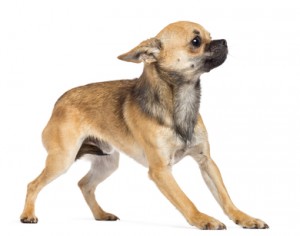Aggression Due to Medical Problems
Occasionally, aggression in dogs can be the result of a medical issue. Dogs with certain injuries, medical conditions or diseases can develop aggression issues. An example is hypothyroidism, a common hormonal imbalance in both dogs and humans. In humans, hypothyroidism may cause weight gain and depression, while in dogs, the first obvious sign may be heightened aggression. A veterinary exam followed by corrective medical treatment can sometimes result in improved behavior.
Genetic Predisposition
Dogs from particular breeds and/or bloodlines can be predisposed to aggression. All dog breeds originated for a purpose, and there are certain breeds that have aggression built into their genetics. Some small terrier breeds are known for being dog-aggressive, while some hunting breeds display predatory aggression towards small animals like birds or rabbits. Guarding and dog-fighting breeds can be predisposed for aggression toward both people and other dogs, and many dogs in these categories are large enough to cause severe injuries or death to people and animals. Fighting breeds are bred to have a “grip & shake” fighting style and can inflict extreme damage quicker than other breeds.
 Fear-Motivated Aggression
Fear-Motivated Aggression
Dogs that are fearful of their own safety can pose a bite risk. The threat is from the dog’s perspective and can be real or imagined. Fear aggression can be triggered by such things as the arrival of a bearded male stranger, or by the owner doing something “scary and inescapable” such as restraining the dog in order to clip its toenails. These dogs do not seek out situations to be aggressive in and will try to avoid the perceived danger.
Protective Aggression
This most commonly happens when a mother is protecting her pups, and may be directed towards humans and other dogs.
Territorial Aggression
Dogs may guard their home, yards, and space. They may view visitors, such as neighbors, delivery people, or other animals, as a threat. They will sometimes lunge at the “invader” or bark at the invader from a front window or from inside a fenced yard. This type of aggression is commonly seen in breeds that originated to guard farms and livestock.
Resource Guarding
This is the dog’s attempt to control and guard resources such as food, toys, treats, rawhides, or even the owner. A resource guarder may stand near its owner or a bowl of food and growl at anyone—human or non-human–who tries to approach.
Predatory Aggression
This type of aggression is driven by an animal’s desire to hunt for food. This is often referred to as “prey drive” and can be seen when dogs are chasing smaller dogs, cats, small animals, or wildlife. There are some unanswered questions about this type of aggression since dogs are considered scavengers and most dogs do not consume the prey items they have killed.
Frustration/Redirection Aggression
When a dog is frustrated and cannot do what it wants, it may attack the nearest person or pet. This can happen when a dog is frustrated about being restrained. For instance an indoor dog may glimpse another dog walking by outdoors, or hear someone knocking at the door. Not being able to reach the real target (the dog or the person knocking), the dog may instead lash out at a nearby dog, cat or person.
Pain-Induced Aggression
Even normally-gentle animals can become aggressive when in pain, and can attack the person trying to help them. It is advised to be very cautious around a dog in pain. Owners are often bitten while attempting to help their own dogs. This particular issue usually dissipates as soon as the crisis is resolved.
Social Aggression
Dogs naturally live in packs, including both other dogs and humans. Most dogs find their place in the family hierarchy without ever resorting to aggression. In fact, dogs who have true leadership skills are often the most benevolent and laid back animals in the household. Real “kings and queens” of the pack can spend an entire lifetime in control without a single growl or fight. Unfortunately, the truly weak dogs in the family may resort to growling and starting fights in an attempt to bully their way up the hierarchy. Social aggression can occur in either sex, and in both intact and neutered dogs. Social aggression tends to be most serious and long-term between two females than either of the other combinations.
Unpredictable Aggression
Some dogs may have aggression that does not occur on a consistent or predictable basis. There may be no reason or trigger for the aggression. Some dogs are simply not “wired” correctly. Many fighting breeds have been purposely bred for hundreds of years NOT to give any signal or prior warning prior to launching an attack. Many dogs of these breeds can have a high tolerance for annoyance, but a sub-set eventually reach a breaking point and lash out with no warning. Every week, another owner sobs that their dog had “never shown a sign of aggression in its life” until it mauled a child, visitor, or the owner himself/herself.

I want them to be ban to save them. Criminals love owning and breeding them. If we ban them and other “dangerous breeds”, they can never be in the wrong hands. No can breed or own one for their cruel dog fighting or to be tough. You should google search why Pitbulls attack Sam trainer.
Of course this doesn’t mean I disagree with banning, or muzzled pits. Just because they aren’t bred for human aggression (usually because some breeders might jack them up) that doesn’t mean that pits are off the hook. They are dog aggressive and that is in their genes. Dog aggression can’t be taken out of them. No one wants their dog to get killed by Pitbulls. This is coming from a pit lover. Well I’m more neutral, but leaning towards pro pit/pit lover. Sorry pit lovers, but dogs are family too. I don’t want my pit to get attack by another pit and I don’t even own one. Even though there are a lot a pit attack, it doesn’t mean that most pits attack people. YouTube search Pitbulls saving lives. What are number of pits who save lives? Idk. Maybe is likely to get report, but that doesn’t mean it happens less.
Hello
So I have a pit mix 8 years old
She is people aggressive with strangers and dog aggressive
A couple of times recently she has shown strong aggression towards my cats with whom she was raised with
She did not hurt them ,however it sounded as if she caused serious damage
I have my 2 1/2 year old grandson living with me and I worry that she may turn on him
She has showed no signs of aggression towards him
Yet ,but I fear she may turn on him as well
Please let me know what you think I should do
I have went back and forth trying to decide wether I should peacefully euthanize her to keep the family safe ,but I am torn and it breaks my heart to have to make this decision
She is just so unpredictable and my fear may one day be a reality
This is a no-brainer. The facts are right in front of you. How torn and broken-hearted will you be when you are facing the fact you KNEW you had an aggressive dog when it’s too late and your grandson is gravely injured or killed? I am not intending to be rude, I am intending to be honest. Get rid of the dog. There are hundreds of safer options out there.
A pit that is human aggressive is not a normal pit and needs to be put down. However don’t think that human aggression is normal in pit bulls. They aren’t normally bred for human aggression. They are bred to fight other dogs, not us. They were also bred to bait bulls. Notice how pits were bred to things that have to do with other animals and not us. They aren’t bred to fight us. Pitbulls get kill in dog fights if they show human aggression. Maybe there are some breeders that are breeding human aggressive pits, but most don’t. Just in case a fight gets out of control, they want to stop it and it’s easier to that if the dog is only dog aggressive.
If more owners of dog breeds that have inherent traits that include unpredictable aggressive behavior would accept what those traits are and deal with them appropriately, instead of ignoring them, claiming they are not real, or making excuses for them, there would be less dog attacks that maim or kill.